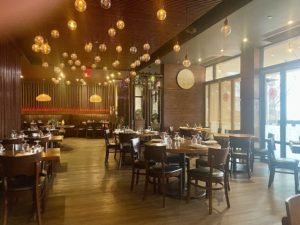Table Talk: An authentic taste of China in Fairfield

I”™m not usually one for restaurant customer reviews, because they can put your head in a spin. Customer A posts, “Our favorite bistro.” Customer B posts, “Stay well away.” That said, I was intrigued by the most recent Google review of Ginkgo Sichuan Cuisine, a Chinese restaurant in Fairfield, which I”™d always heard good things about but had not gotten around to visiting in the six years since it opened. The online reviewer, David, location not given, had simply posted, “Best f****** Chinese.” Not even an exclamation point ”“ and the asterisks are mine and mine alone. A tell-it-like-it-is kind of guy, a man of few words is David, but if brevity really is the soul of wit, then this may be the best online customer review I”™ve ever read.
I”™ll tell you what: It certainly whetted my appetite to eat at Gingko, especially with the Lunar New Year (Jan. 22, the Year of the Rabbit) just around the corner.
Located at the far end of the unlovely low-build Fairfield Centre ”“ the most exciting feature of which may be its Anglo/French spelling of “center” ”“ Gingko has put some real thought into its design, unlike many faceless shopping mall restaurants. Outside, there”™s a pretty if narrow heated terrace facing the parking lot and inside, a veritable canopy of filament bulbs, which seem to mimic Chinese lanterns, so do look up. With a bit of imagination ”“ OK, a lot ”“ you could imagine yourself on a junk at night, sailing in Hong Kong Harbor. At floor level, high-backed banquettes, generous, semicircular booths, and heavy use of teak are also a pleasing throwback to the era of comfortable Chinese restaurants, before places like Hakkasan and Vong started to reimagine Asian cuisine in the early 2000s, introducing a heavy design element into the experience and halving the portion sizes in the process.
That”™s never going to be an issue at Gingko, where the super-sized portions mean you will carry more home in a doggie bag than you stand any reasonable chance of eating at the table. But I”™m getting ahead of myself.
Sichuan cooking implies heat from chili peppers and the liberal use of garlic, tempered with spices such as fennel seed and star anise. On a menu that is so long you might consider familiarizing yourself with it online at home before your visit, starters include surf clam in pepper sauce, various kinds of dumplings, Shanghai spring rolls and beef noodle soup. The rolls, served with a sweet chili sauce, come to the table absolutely piping hot, the batter so thin and crisp it shatters on impact as you bite into them. The soup, a Sichuan classic, hits you in the back of the throat, where it should. It is rich, wintry and immensely satisfying. Other starters I and a small group of friends enjoyed included moreish salt and pepper baby squid, Chengdu-style cold noodles (Chengdu is the home of Sichuan cooking) and fermented black bean-flavored spare ribs. Yet another was a Peking duck-filled bao, or bun, with the more familiar Peking duck with green onions and streamed pancakes served as an elaborate main course. Just remember to order it at least two hours in advance.
The jury was divided over a dish of sliced sweet and sour jellyfish, with its slightly woody, cartilage-y texture. For myself, I quite enjoyed it but wouldn”™t rush to reorder it.
If the restaurant has a signature dish, it is the Sichuan dry pot, a large hot pot of vegetables and spices built around one core ingredient. That might be chicken or beef or pork belly, but it might equally be chitterlings (intestine) or Chinese bullfrog. This is a restaurant that doesn”™t dumb down its menu to take account of “local” tastes or sensibilities but rather strives to deliver the real deal. Further authenticity comes in the form of the ma-la dishes, which derive their heat from Sichuan pepper, a unique peppercorn with a zingy, almost citrussy undercurrent.
In addition to the dry pot and a couple of vegetable dishes with ma-la vegetable sides, we also gave the thumbs up to a large dish of shredded beef with celery, green chilies and ginger. It was cooked with a mountain of red chilies, which, left whole, were mercifully easy to see and remove. A side of Singaporean noodles ”“ the East”™s equivalent of angel-hair pasta ”“ with soft onions and almost translucent, barely cooked shrimp provided a kind of balm to the hotter dishes.
Claggy white rice, precooked and not kept sufficiently damp, and jasmine tea, rather swamped in a large teapot so that the flavor had all but gone, could hardly take the pleasure out of what was a delicious and rewarding dinner. So, thank you, David, whoever you are, for the ace review.
On my first trip to Beijing ”“ so long ago now that let”™s just say President Richard M. Nixon only beat me by a hair”™s breadth ”“ I took with me Fodor”™s guide to China, in which the great Eugene Fodor himself had written this immortal line about Feng Shang, then the most prominent restaurant in the Chinese capital: “Feng Shang is the best restaurant in Peking,” he penned, “which surely makes it the best Chinese restaurant in the world.” It was hard to argue with the logic. Now, I can”™t make any such sweeping claims for Gingko, but I will stick my neck out and say it is the best Chinese restaurant in Fairfield, and very likely our region.
For more, visit gingkoct.com.